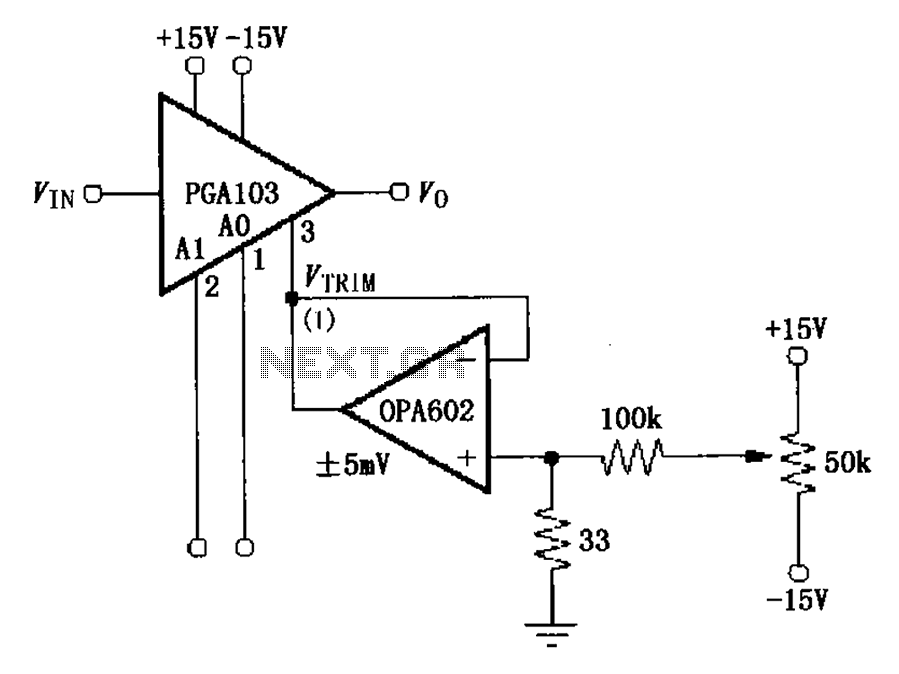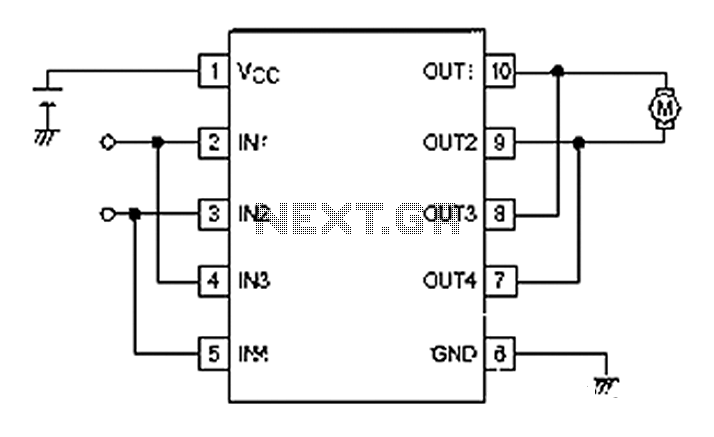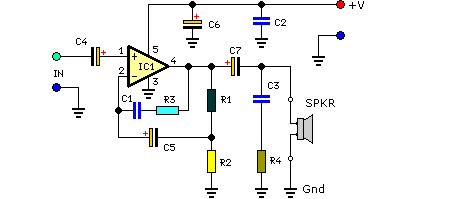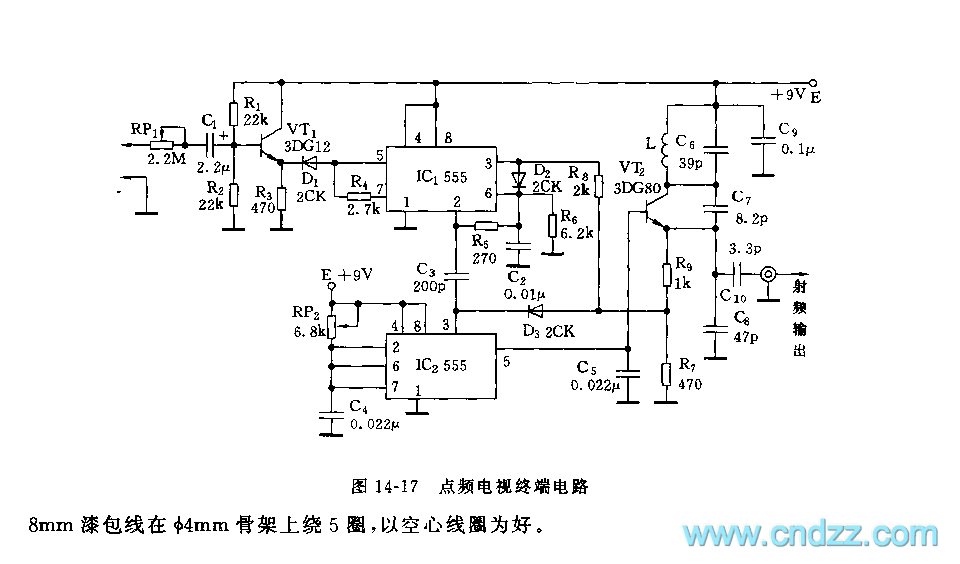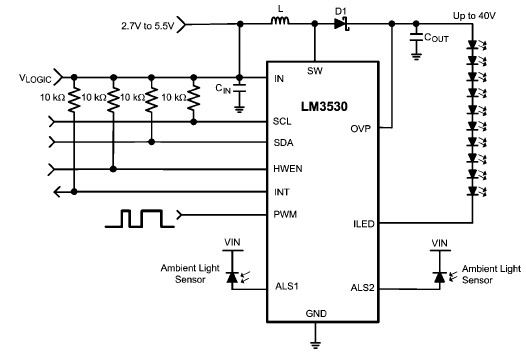
0-50V 2A Bench power supply circuit and explanation
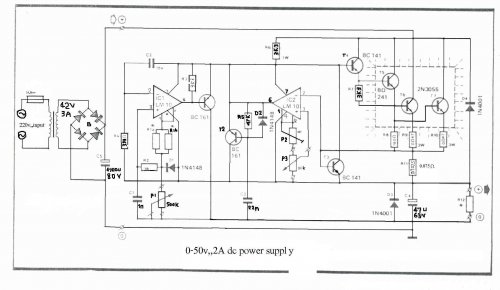
The LM10 integrated circuit (IC) is utilized due to its reference voltage feature, which is advantageous for DC power supply applications. By employing two LM10 ICs, different output voltages and current levels can be achieved. This circuit includes short-circuit protection. P2 is designated for current control within a range of 0-2A. The output voltage is stabilized using resistor R4 connected to the negative pin of the operational amplifier (op-amp), while resistors R2 and potentiometer P1 are connected to the positive pin. The output of the op-amp drives transistor T1, which mitigates voltage ripple. Transistor T1 adjusts the current flowing through resistor R6, thereby controlling the voltages at T5 and T4. The first pin of the LM10 serves as the reference voltage, which experiences a slight voltage drop across resistor R1, allowing for a current of 100 µA to flow. This current also passes through potentiometer P1. The voltage drop regulates the output voltage, which is compared against the reference voltage at P3 and the voltage drop across resistor R11. Transistor T3 provides short-circuit protection in conjunction with resistor R11. To reduce the output voltage to 0V, a 470-ohm resistor should be connected in parallel at the output. The minimum output voltage is 0.4V, while the maximum output voltage is limited by resistor R1b and should not exceed 50V. Consequently, the transformer must supply 36V at 3A, paired with a 4700 µF capacitor. Transistors T6, T5, and T7 require heat sinks for thermal management.
The circuit design primarily revolves around the LM10 IC, which serves as a voltage reference and an operational amplifier in this configuration. The dual usage of LM10 allows for flexibility in output specifications, enabling the user to achieve desired voltage and current levels tailored to specific applications. The inclusion of P2 for current control enhances the circuit's versatility, allowing for adjustments between 0 to 2A, which is crucial for various load requirements.
The stabilization of output voltage is a critical aspect of this design. The resistors R4, R2, and P1 work in unison to ensure that the output remains steady despite fluctuations in load. The op-amp output's influence on transistor T1 is vital as it acts as a regulator, preventing voltage ripples that could adversely affect downstream components. The ability of T1 to modulate the current through R6 plays a significant role in maintaining the desired operational parameters.
The reference voltage management is also noteworthy; the voltage drop across R1 creates a feedback mechanism that helps maintain the output voltage. The interaction between P3, which establishes a comparison point, and the voltage drop across R11 ensures that the circuit can react dynamically to changes in load conditions, providing robust performance.
In terms of safety, the inclusion of T3 and R11 for short-circuit protection is essential in preventing potential damage to the circuit. This feature enhances the reliability of the power supply, making it suitable for sensitive applications where overcurrent conditions may occur.
The output voltage range is well-defined, with a minimum of 0.4V and a maximum limit of 50V, dictated by R1b. This range allows for a wide variety of applications, from low-voltage devices to those requiring higher voltage levels. The specification of a transformer providing 36V at 3A, along with a significant capacitance of 4700 µF, indicates a design that can handle substantial load demands while maintaining stability.
Finally, the thermal management of the transistors T6, T5, and T7 is emphasized, as these components will dissipate heat during operation. Adequate heat sinking is necessary to ensure reliable operation and longevity of the circuit, particularly under high load conditions.I use the lm10 IC because it has a reference voltage and that`s useful for dc power supply. With two ICs can take different output voltage and amperage. This circuit is protected from short circuit. P2 is for controlling the current at the range of 0-2A. Stabilize the output voltage with R4 on negative pin on op-amp and with R2 & P1 on positive pin . Op-amp output controls T1 that not let ripple of voltage. T1 increase or decrease ampere of R6 and control the voltage of T5 & T4. Pin 1 is the reference voltage and reference voltage is losing some voltage on R1 that has 100uA. This current passes through P1 too. This lose voltage regulate output voltage rate of output current is compare between reference voltage of P3 and lose voltage on R11. T3 is protecting short circuit with R11. For reduce out put voltage to 0v should parallel one resistor 470 ohm in out put. Minimum voltage is 0. 4v. The maximum output voltage is fixed with R1b and should not become over of 50v. Therefore your transformer should give 36V, 3A with 4700uF capacitor. T6, T5, T7 need heatsilk. 🔗 External reference
The circuit design primarily revolves around the LM10 IC, which serves as a voltage reference and an operational amplifier in this configuration. The dual usage of LM10 allows for flexibility in output specifications, enabling the user to achieve desired voltage and current levels tailored to specific applications. The inclusion of P2 for current control enhances the circuit's versatility, allowing for adjustments between 0 to 2A, which is crucial for various load requirements.
The stabilization of output voltage is a critical aspect of this design. The resistors R4, R2, and P1 work in unison to ensure that the output remains steady despite fluctuations in load. The op-amp output's influence on transistor T1 is vital as it acts as a regulator, preventing voltage ripples that could adversely affect downstream components. The ability of T1 to modulate the current through R6 plays a significant role in maintaining the desired operational parameters.
The reference voltage management is also noteworthy; the voltage drop across R1 creates a feedback mechanism that helps maintain the output voltage. The interaction between P3, which establishes a comparison point, and the voltage drop across R11 ensures that the circuit can react dynamically to changes in load conditions, providing robust performance.
In terms of safety, the inclusion of T3 and R11 for short-circuit protection is essential in preventing potential damage to the circuit. This feature enhances the reliability of the power supply, making it suitable for sensitive applications where overcurrent conditions may occur.
The output voltage range is well-defined, with a minimum of 0.4V and a maximum limit of 50V, dictated by R1b. This range allows for a wide variety of applications, from low-voltage devices to those requiring higher voltage levels. The specification of a transformer providing 36V at 3A, along with a significant capacitance of 4700 µF, indicates a design that can handle substantial load demands while maintaining stability.
Finally, the thermal management of the transistors T6, T5, and T7 is emphasized, as these components will dissipate heat during operation. Adequate heat sinking is necessary to ensure reliable operation and longevity of the circuit, particularly under high load conditions.I use the lm10 IC because it has a reference voltage and that`s useful for dc power supply. With two ICs can take different output voltage and amperage. This circuit is protected from short circuit. P2 is for controlling the current at the range of 0-2A. Stabilize the output voltage with R4 on negative pin on op-amp and with R2 & P1 on positive pin . Op-amp output controls T1 that not let ripple of voltage. T1 increase or decrease ampere of R6 and control the voltage of T5 & T4. Pin 1 is the reference voltage and reference voltage is losing some voltage on R1 that has 100uA. This current passes through P1 too. This lose voltage regulate output voltage rate of output current is compare between reference voltage of P3 and lose voltage on R11. T3 is protecting short circuit with R11. For reduce out put voltage to 0v should parallel one resistor 470 ohm in out put. Minimum voltage is 0. 4v. The maximum output voltage is fixed with R1b and should not become over of 50v. Therefore your transformer should give 36V, 3A with 4700uF capacitor. T6, T5, T7 need heatsilk. 🔗 External reference
